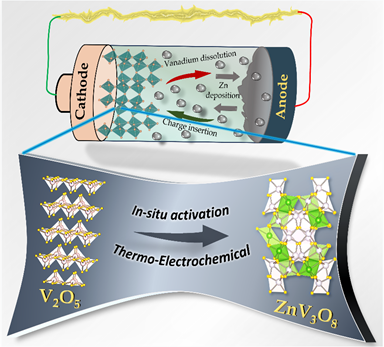Bengaluru based scientists have unveiled a breakthrough that could power the next generation of eco-friendly batteries. Moving beyond lithium batteries, the currently favourite one, researchers have designed a cathode material suitable for the more environment friendly Zinc batteries. This can enhance the energy density and stability of the materials resulting in more efficient batteries.
Significant advances in energy storage over the past few decades have been focused largely around lithium batteries because of their desirable performance - mainly high energy density, although they come with several environmental and safety risks during use. As an alternative, recently, aqueous zinc-ion-based battery (ZIB) systems have been attracting attention due to their high energy storage capacity, safety, and environmental friendliness.
Researchers around the world are developing various cathode materials that can be suitable for zinc-ion-based electrolyte systems and can last for a long time with high energy storage capacity. Several oxide materials are already being investigated in this regard, but have failed to demonstrate the required performance in zinc-ion-based systems due to many limitations.
To solve that, a research team led by Dr. Ashutosh Kumar Singh of the Centre for Nano and Soft Matter Sciences (CeNS), an autonomous institute under the Department of Science & Technology (DST), Government of India, have come up with a new simple strategy to activate the cathode material by thermo-electrochemical treatment to modify its structure. This could help the batteries gain high energy storage performance. This represents a straightforward and efficient approach to enhancing the overall energy density and stability of the usual cathode materials.

Fig. The in-situ thermo-electrochemical activation of V2O5 cathode material.
The innovation lies in a simple "activation" process for a common battery material, vanadium oxide (V2O5). By treating it with a special combination of heat and electricity, they transformed its structure, deliberately creating useful "flaws" or defects. Think of it like turning a solid, smooth wall into a porous, spongy one. This new, imperfect structure, called zinc-vanadium oxide (Zn-V2O5), has tiny spaces and pathways that allow it to store and release far more energy efficiently compare to V2O5. The Zn-V2O5 structure also allows for hydrogen ion interaction from the battery's electrolyte, thereby improving structural stability and lowering the barrier for zinc ion movement during battery charging/discharging processes.
The activated material enables the zinc-ion battery (ZIB) to achieve a dramatically higher energy density and incredible longevity. It can store much more energy and be recharged thousands of times without significant degradation.
These findings by Dr. Ashutosh Kumar Singh and his team recently published in the Advanced Energy Materials, tackling a long-standing challenge in zinc-ion battery research.
Mr. Rahuldeb Roy, a co-author of the research, said, “By realizing the difficulty involved in stabilizing the cathode material as well as structurally modifying to gain the enhanced performance, we opted for an oversimplified but novel strategy to activate the usual cathode materials used for Zn-ion battery.”
He added that this study not only advances the field of ZIBs but also this particular technique can also be applied to other cathode materials to enhance storage performance. It could lead to greater efforts to develop sustainable and efficient energy storage technologies for a greener future.


